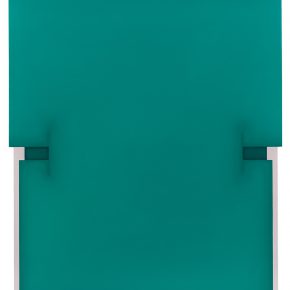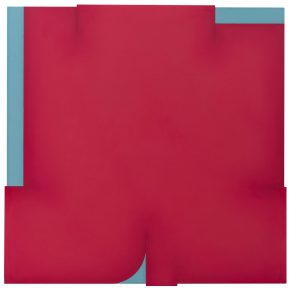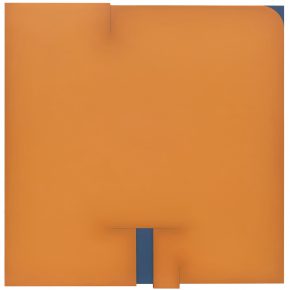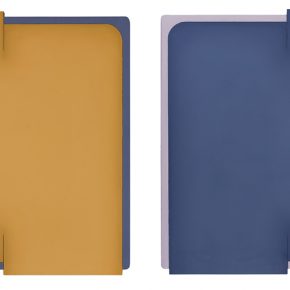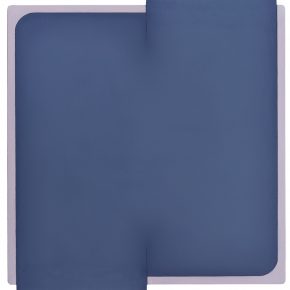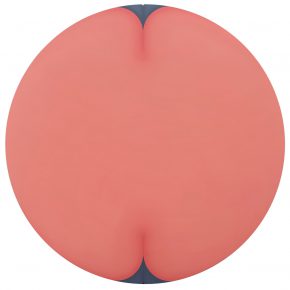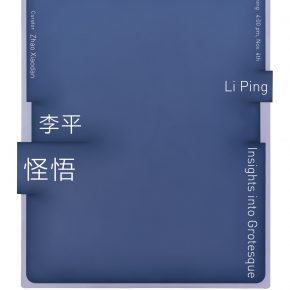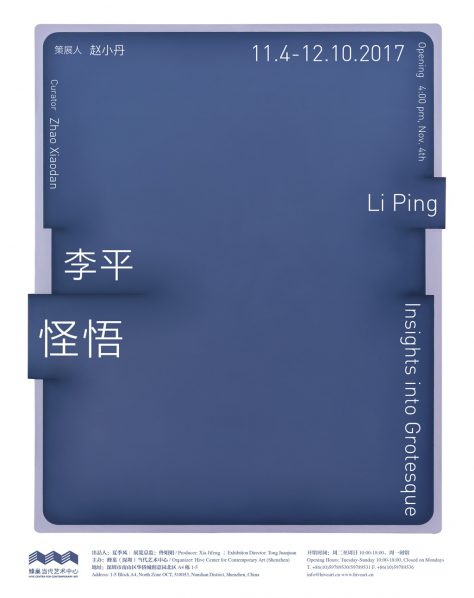
Hive Centre for Contemporary Art (Shenzhen)?is pleased to announce the opening of “Li Ping: Insights into Grotesque” on?4th Nov.?2017. It’s the artist’s second solo exhibition in cooperation with?Hive. Both the “Insight into Grotesque” series in this show and the “New Substance”?series?displayed?in 2015?are originated from the idea of extending “object”—the carrier and feature of minimalist painting; what’s?different is that “Insight into Grotesque” can be dated back to his visual experience of observing the monster images in medieval buildings when he studied in Italy years ago. He?distilled the elements of “image” when studying the pattern of medieval monster thinking,?which can?also?be caught?by viewers from his new works.
One of the reasons why he implants “image” in his new works is his concern for the tendency where minimalist painting that is supposed to be “geometry”-based has become increasingly formalized. After reflecting on this and his own practice, he makes such a transition. To?a?certain extent, “image” is figuratively connotative, and when being presented in an abstract mind, it lays a particular emphasis on what’s?inside the painting form and the related aesthetic experience.
Specifically, the video work showcased in this exhibition manifests the constant line running through his artistic practice, and?tells of his exploration in form made in?the?“New Substance” series through the performance of light?and?shadow, the patchwork of wood panels and the combination of pure colors. The other works also depart from this very point, link the problems to be rendered in his new works—like the boundaries between lines and objects, the shapes of colors under rational control and?the individual imagination, etc., and try to generate?more possibilities of perceiving through these problems.
About “Insight?into Grotesque”
On Li Ping’s New Works
By Zhao Xiaodan
This is Li Ping’s second solo exhibition held in Hive Center for Contemporary Art. Compared with his previous “New Substance”?series in 2015, the works displayed this time still concern minimalist painting because they also extend the characteristic of “object”, whereas the series entitled “Insight into Grotesque” displayed in this solo under the same name are an attempt made to bring back “image”—an attempt based on his life experience and various?results of perceptual implication.
Personal experience and perceptual implication,?if written into text, are two very independent lines. Yet in reality, they often converge into one and their junction is as blurring as a grey zone. ?The following description, to some extent, clarifies the boundary of this grey zone. Yeas back, Li Ping studied at Academy of Fine Arts of Bologna in Italy, and this history changed his art-making path he had held in China, for?instance: Lucio Fontana who claimed to?have?“tried to break?the dimensional limitations”?of the canvas?and “created an infinite dimension” is roaring and significant for Li Ping. In this exhibition, his first?video produced when studying?in Italy can be regarded as a response to Fontana’s manifesto, although the video was originated from the moving-image-like impressions on the KT board accidentally projected by the light cruising in the dark. Apparently the ephemeral yet continuous vacillating makes the light-and-shadow, object and spatial energy based on?this experience?the starting point of his later easel painting, i.e. the “New Substance” series created from 2013 to 2016. During these four years, Li Ping explored?the?formal?possibilities in light?and?shadow, the patchwork of wood panels and?in?the combination?of pure colors, and his pictures?would?remind viewers of the horizontal or vertical folds caused by the movements of?sound waves or?musical notes in sharps or flats. He wants to fluctuate viewers with?these folding rhythms. “New Substance” is composed mainly by lines, while?the?“Points” series made in 2014,?though odd?in?form and very catchy, slips off his main track of artistic creation, so he ended?it after experimenting for a while.
It’s necessary to explicate the context in which he made?the?“Points” series, especially for the reason that?the?“Insight into Grotesque” series in one way or another furthers the idea developed in “Points”. As mentioned above, Li Ping studied in Italy earlier, and it’s right during that period of time?that?he saw a large number of medieval remains almost anywhere he went, particularly the images of man and animals in sculpture or architecture, and they look?extremely absurd and grotesque against his own cultural background. At that time, grotesque myths existed as a way of interpretation rooted in the unknown?territory between the authority of church and the animism in the folk tradition, but in fact, the cognitive imbalance among different groups?gave a kind of space to the coexistence of men and gods?which, non-governmental so rarely recorded in professional texts, can only?be found?in novels and genres alike. From then?on, Li Ping closely observed these grotesques, carefully studied the researches on medieval monsters and read related writings. This?journey of survey inevitably drew?him towards new images. Consequently, the “Points” series was produced. Although,?to some extent, the naming of “Points” responds to the?predecessor?minimalists’ works that have holes poked through the?canvas. The emergence of “Insight into Grotesque” pieces together the line?that?almost falls apart. Furthermore, we can even say that in the “Points” and “Insight into Grotesque” series, Li Ping tries to implant realistic images onto the wood panel. Then the question?that?confronts him is, in what forms the images should stay on the panel so that they can be a kind of real existence that only gives?viewers a sense of speechlessness?at a?moment?in terms of the logic of viewing, without being seen through at one glance.
Behind the return of “image” in his works, there lie twists and turns of life. Back to China from Italy, the context of his art practice has shifted one more time, so his painting has seen a transition from realistic to non-realistic and to realistic—the connotation of?the?second “realistic” has been altered compared with the first one. From the critical and realistic works made before he left for Italy?and?the minimalist language drawn by Li Ping out of Western modernist painting and dominant in his further creations?to?the experimentation of surviving image in abstract language, this?threefold path of alteration?has roughly silhouetted the site-specific features of his art practice. This is neither the same with the logic of minimalist painting that follows modernism in the Western orthodox lineage, nor the same with the logic of Chinese abstract painting, the logic that advocates to resist realism. Parallelly speaking, although,?to a considerable extent, pop and neo-expressionism are actually a return to “image”, the images in Li Ping’s new works haven’t altered?culturally, but become rather realistic. In simple terms, the figurative soul adopts the abstract expressions to deliver the form of abstract painting.
In A Brief History of Mankind, Yuval Harari?expounded the relationship between human development and “fiction” or,?in one way or another,?what we call as “imagination”. And as a reader of this book, Li Ping reiterated Harari’s “imagination” and the forms of fictive animals in medieval animal fables. When he juxtaposes these two, he gradually reveals the transitional node of his new works. The foothold of minimalist painting is “geometries”, but the gradually formularized abstract painting of today becomes visually dull and psychologically pale, which’s one of the factors that propel Li Ping to make a change. The orthodox of minimalist painting, when no longer demanding?the painterly subjectivity defended by abstract expressionist painting, gives places to?the discussions of objects and boundaries raised by Stella, Reinhardt, Fontana, Mangold, etc. So how should Li Ping, an insider of this system too,?take his road? To reflect on the totality of abstract painting, and to simultaneously reflect on himself. Li Ping again picks the vehicle of his practice, the “object”—wood panel, and also faces the problem of how to convey the information concerning the power of perceiving through “point-line-plane”. In his new works, Li Ping slowly banned the parallel fluctuations, vertical space and obvious light and performance of light-and-shadow seen in his previous series; still,?the large-area pure color has been adopted, together with surrounding complementary color to drive the whole shape into a binary logic. Given suppressed light source, the major pictorial movement has to rely on the short lines in the middle and on the collaged frame. The movement of bundling or fastening perhaps and the colors obviously stand opposite each other. The movement and the concave-and-convex design of frame proportion shape?the slightly bulging pure color into an enchanting space. Although the intention of Li Ping is not to build a place for viewers to obtain immersive experience, yet to a large extent, the frame of complementary color and the diminishing of pure color tone manifest his rational control over painting. Especially the oval pieces, with the application of symbolic colors and the use of slightly bulging space, plus the specific image he tries to implant, evoke multiple associations with painting images. In this sense, the “Insight into Grotesque” series brings about?a real existence that is both independent from realism and can be silently observed and reflected on.
The interpretation of “Insight into Grotesque” above has probably expounded Li Ping’s understanding of?“Insight into Grotesque” from the perspective of perception and experience. Therefore, a conclusion may be drawn: the?overwhelming coercing of realism and the stir of “image” problem give life to these new works?of Li?Ping’s, where?all the elements—the realistic nutrition he resorted to, the trigger of the image problem (the medieval grotesques logically perceived by him), and the induction of Harari’s imagination— have been implanted?in the wood panel that has a logically fictive existence of “point-line-plane”. The logic supporting his art-making is now visible and vivid. And as an extension, we can say that Li Ping’s works are still dependent on figurative logic. As for the problem of abstraction and of extending individual’s experience and perceptive dimensions, what faces Li Ping is not only the problem of coordinating the tendency of perception and “imagination”, but also the problem of closely observing the objects beyond the works. Let’s wait and see.
About the exhibition
Curator: Zhao Xiaodan
Opening:2017.11.4 16:00
Exhibition Dates: 11.4 - 12.10.2017
Organizer: Hive Center for Contemporary Art (Shenzhen)
Add: 1-5 Block A4,North Zone OCT, ,Nanshan District, 518053 Shenzhen, China
Courtesy of the artist and Hive Center for Contemporary Art, for further information please visit www.hiveart.cn.


